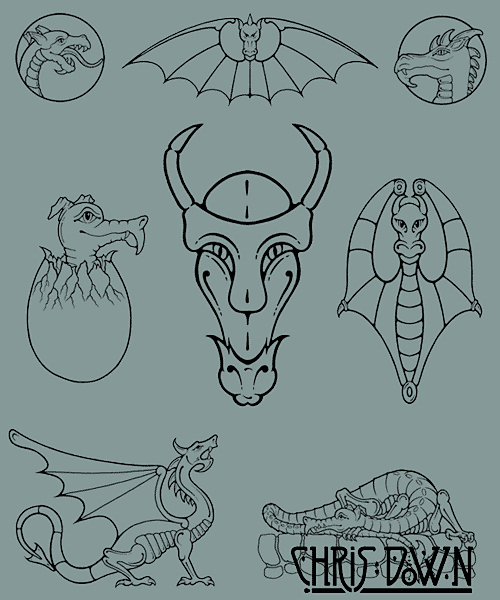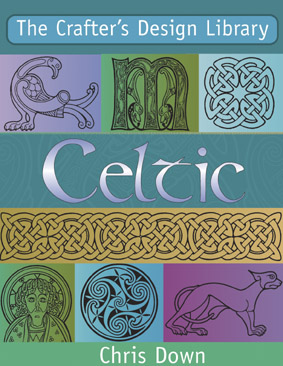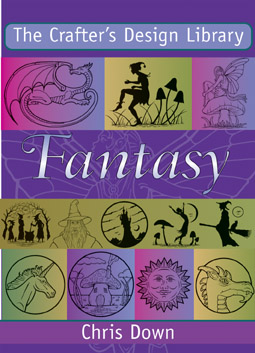There have been periods where I have established relationships with a number of publishing houses. Of them, Blandford Press, Thorsons/Element and Llewellyn Worldwide form the bulk of my publishing commissions and I worked for each over a several years. In addition there is one other publishing house which stands out or me and that is David & Charles and the the Crafter’s design Library source books I produced for them.
Occasionally an approach for a commission can come out of the blue. This was one such case. I was not even aware of the company at the time of the approach to illustrate a book for them. It turned out they were a long established and well regarded for their craft books. Such is the way of things, they have now unfortunately been completely subsumed by a much larger international conglomerate. I am really pleased I got to work with them when I did. A nice touch was the person who gave me my first book commission when he worked for Element Books, Roger Lane, had moved on to work for David & Charles.

The two books I produced in the Crafter’s Design Library series with David & Charles were the most hands on collaborative process I had had with publishers, it felt like I was a part of the team. My main point of contact was the commissioning editor, Fiona Eaton. We talked through the development of the books continuously through the process, often a couple of times a week. The books were so much better for that collaborative process. I do think collaboration brings out a stronger result.
I was approached for my Celtic artwork and that was the subject of the first book. Once that was complete I pitched the idea of a follow up based on Fantasy art. Which really led to a whole new strand of work after its completion as I explored the fantasy genre as opposed to Celtic. So the books represented a strong transition in my work as the Celtic art declined after producing them and fantasy figurative painting became my artistic focus for over a decade.

At the beginning though it was full on Celtic as I got to grips with the first of the two books. I supplied some 350 illustrations for this book. Thankfully, I had a great deal of material to draw on. All the same, a lot of fresh material needed to be produced and for several months I was working 15 hour days to make it happen.
The follow up in the series was no less demanding as I had six months to produce 250 illustrations for. I had no existing work for these, so everything had to be produced from scratch for the second book. Over the two year period of these books production, I also illustrated a couple of books for the Thorsons imprint of Harper Collins. Meaning in that two year period I produced some 700 illustrations. Something, to be honest, I don’t intend to do again. There is more to life than being sat at a drawing board.
However, I am very glad to have done the two Crafters’ books. They were reprinted in a number of foreign editions and produced in both hardback and paperback. They did go on to sell tens of thousands of copies worldwide.
Details of the Crafters’ Design Library Celtic
The Crafter’s Design Library: Celtic
By Chris Down
Published 2003
ISBN:0 7153 1441 6 (hardback UK)
ISBN 0 7153 1442 4 (Paperback US)
279 x 216mm – 128 pages
350b/w templates
20 colour photographs
20 colour illustrations
Contents:
Part One – The essential techniques:
– introducing Celtic art
– about this book
– ideas for crafting
– applying motifs to craft media
– adapting and embellishing designs
– creating new looks
– using and adapting border designs
– using colour
– project gallery.
– Part Two – The templates:
– knots
– zoomorphic
– spirals
– saints and angels
– Tree of Life
– La Tene
– alphabets.

Choose from over 350 striking Celtic motifs, patterns and pictures and apply them to all your favourite crafts. Whether used for quilting, glass paintings or stencilling, this rich abundance of source material will provide bundles of inspiration. Crafters of all skill levels need an extensive selection of motifs and patterns to apply to their work. This sourcebook provides a rich and varied source of superb quality Celtic motifs, all of which can be copied and applied to a range of crafts.
Part One: this is an introduction to the history of Celtic art, before going on to show, step-by-step, how to trace, photocopy and even scan the images. After showing how to copy the templates, this section goes on to describe how to apply them to a number of crafts, from cross-stitch, needlework and quilting to glass painting, metal embossing, stamping and more. Applying colour to the patterns is also discussed.
Part Two: this is the extensive library of Celtic motifs. Knots, borders and spirals are always favourites with crafters, as they are so versatile and can be as subtle or striking as required. Zoomorphic images, along with Saints and Angels, show animal and human forms depicted in the unique Celtic style. The embellished lettering can be applied to any number of crafts,
while the varied Tree of Life section contains Celtic motifs to suit any occasion. Finally, the softer, classic swirls of the La Tène patterns will delight everyone.
The Crafter’s Design Library: Celtic not only provides a rich source of Celtic imagery, but also gives practical advice and inspirational tips on how to use them for any craft of your choice.
Details of the Crafters Design Library Fantasy
The Crafter’s Design Library: Fantasy
By Chris Down
Published 2004
Publishers David & Charles Ltd.
ISBN:0 7153 1579 X (hardback UK)
ISBN 0 7153 1580 3 (Paperback USA)
279 x 216mm – 128 pages
250b/w templates
14 colour illustrations
Contents:
Part One – The essential techniques:
– introducing Fantasy art
– about this book
– ideas for crafting
– adapting and embellishing designs
– adding colour
– applying motifs to craft media
– creating new looks
– project gallery.
Part Two – The templates:
– Fairies, Elves and Pixies
– Witches and Wizards
– Glades and Grottos
– Dragons
– Mythical Beasts
– Horsemen and Heraldry
– Castles, Towers and Turrets
– Other Worlds.
– Celestials and Zodiac.
– Borders and Backgrounds.

Crafters of all skill levels need an extensive selection of motifs and patterns to apply to their work. Part One gives an introduction to fantasy art, before going on the explain how to trace, photocopy and even scan the images. This section then shows, step-by-step, how to apply them to a number of crafts, from cross-stitch and needlework to glass painting, metal embossing, stamping and more. There are even instructions for combining and embellishing motifs, and applying colour. A gallery of completed projects provides ideas and inspiration.
Part Two is the extensive library of clear, high quality Fantasy motifs. The subjects have been carefully considered to give a wide variety of Fantasy images. The motifs progress in complexity within each chapter, starting with simple and easy motifs, moving on to more detailed images. Whether you want a quick motif for a gift card or rubber stamp, or a more intricate look for a beautiful piece of glass painting, there is sure to be lots to delight and inspire.